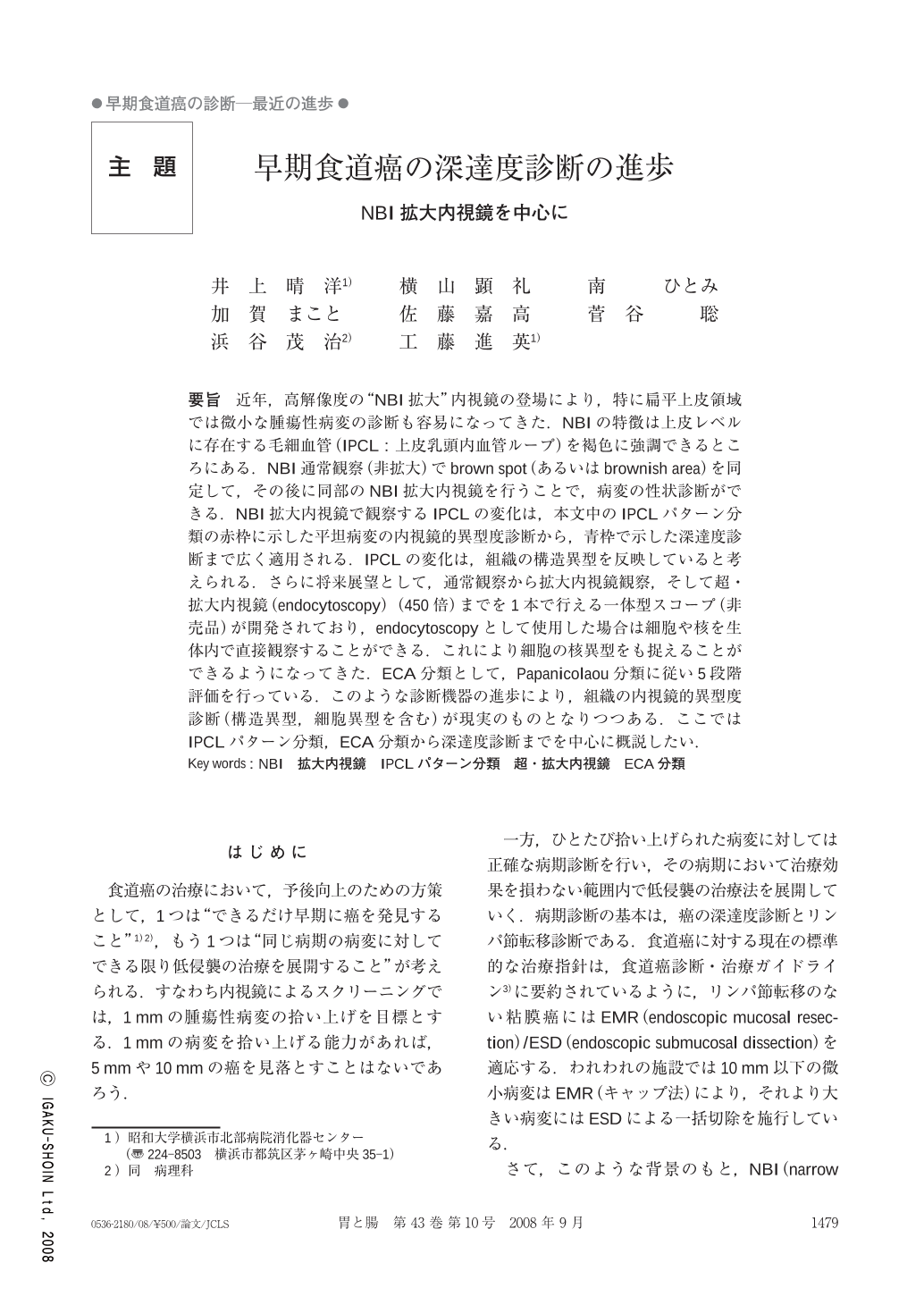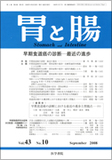Japanese
English
- 有料閲覧
- Abstract 文献概要
- 1ページ目 Look Inside
- 参考文献 Reference
- サイト内被引用 Cited by
要旨 近年,高解像度の“NBI拡大"内視鏡の登場により,特に扁平上皮領域では微小な腫瘍性病変の診断も容易になってきた.NBIの特徴は上皮レベルに存在する毛細血管(IPCL:上皮乳頭内血管ループ)を褐色に強調できるところにある.NBI通常観察(非拡大)でbrown spot(あるいはbrownish area)を同定して,その後に同部のNBI拡大内視鏡を行うことで,病変の性状診断ができる.NBI拡大内視鏡で観察するIPCLの変化は,本文中のIPCLパターン分類の赤枠に示した平坦病変の内視鏡的異型度診断から,青枠で示した深達度診断まで広く適用される.IPCLの変化は,組織の構造異型を反映していると考えられる.さらに将来展望として,通常観察から拡大内視鏡観察,そして超・拡大内視鏡(endocytoscopy)(450倍)までを1本で行える一体型スコープ(非売品)が開発されており,endocytoscopyとして使用した場合は細胞や核を生体内で直接観察することができる.これにより細胞の核異型をも捉えることができるようになってきた.ECA分類として,Papanicolaou分類に従い5段階評価を行っている.このような診断機器の進歩により,組織の内視鏡的異型度診断(構造異型,細胞異型を含む)が現実のものとなりつつある.ここではIPCLパターン分類,ECA分類から深達度診断までを中心に概説したい.
In the esophagus there seems to be nothing equal to pit pattern in the glandular epithelium as an index of structural atypia of the tissue. During magnifying observation we pay attention to IPCL(intra-epithelial papillary capillary loop)as a marker for tissue structural atypia. It is considered that the IPCL changes relate to tissue atypia of the para-basal layer / basal layer. IPCL type classification is expected to be not only a marker of tissue atypia but a marker of invasion depth. IPCL type V-1 in magnifying endoscopy is diagnosed as carcinoma in situ with a tetrad of dilatation, tortuosity, caliber variation, configuration heterogeneity in IPCL. IPCL type V-2,V-3 demonstrates a breakdown of IPCL according to tumor progression. IPCL type VN includes findings that are characteristic of deep sm part infiltration of the cancer. It is supposed that real cancer invasion is in accord with the magnifying endoscopic findings to an equal level or to the deeper layer.
High-resolution endoscopy with NBI magnifying function allows us to detect even minute neoplastic lesions. As a diagnostic process, detection of a brown spot or brownish area is the first step in the detection of such lesions. At the second step, magnifying endoscopy is carried out using NBI magnification. IPCL patterns which reflect structural atypia of the epithelium can be classified into five categories. IPCL type classification can be significantly applied to a flat lesion as endoscopic diagnosis of the tissue atypia. IPCL type IV and V lesions are well treated by EMR/ESD. Magnifying observation has already been enrolled as a part of regular endoscopic observation. Ultra-high magnification endoscopy using endocytoscopy facilitates the observation of cell-level structures in vivo. Endocytoscopic findings are classified into five categories of ECA(endocytoscopic atypia)classification. This endocytoscopic image may be regarded as the third step in diagnosing tissue atypia.

Copyright © 2008, Igaku-Shoin Ltd. All rights reserved.


